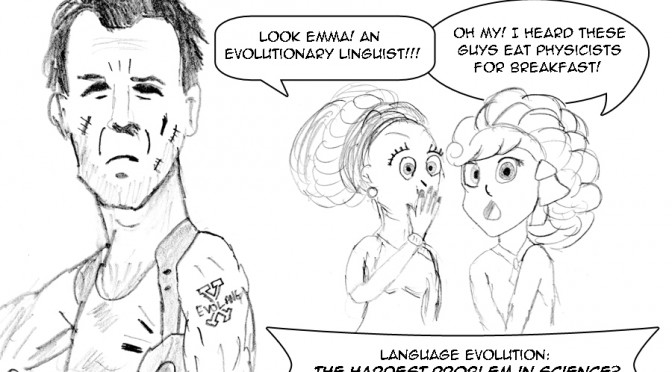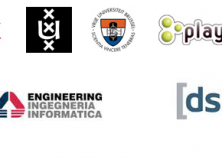There was an awful lot of talk about iconicity at this year’s EvoLang conference (as well as in previous years), and its ability to bootstrap communication systems and solve symbol grounding problems, and this has lead to talk on its possible role in the emergence of human language. Some work has been more sceptical than other’s about the role of iconicity, and so I thought it would be useful to do a wee overview of some of the talks I saw in relation to how different presenters define iconicity (though this is by no stretch a comprehensive overview).
As with almost everything, how people define iconicity differs across studies. In a recent paper, Monaghan, Shillcock, Christiansen & Kirby (2014) identify two forms of iconicity in language; absolute iconicity and relative iconicity. Absolute iconicity is where some linguistic feature imitates a referent, e.g. onomatopoeia or gestural pantomime. Relative iconicity is where there is a signal-meaning mapping or there is a correlation between similar signals and similar meanings. Relative iconicity is usually only clear when the whole meaning and signal spaces can be observed together and systematic relations can be observed between them.
Liz Irvine gave a talk on the core assumption that iconicity played a big role in in bootstrapping language. She teases apart the distinction above by calling absolute iconicity, “diagrammatic iconicity” and relative iconicity, “imagic iconicity”. “Imagic iconicity” can be broken down even further and can be measured on a continuum either in terms of how signals are used and interpreted by language users, or simply by objectively looking at meaning-signal mappings where signs can be non-arbitrary, but not necessarily treated as iconic by language users. Irvine claims that this distinction is important in accessing the role of iconicity in the emergence of language. She argues that diagrammatic or absolute iconicity may aid adults in understanding new signs, but it doesn’t necessarily aid early language learning in infants. Whereas imagic, or relative iconicity, is a better candidate to aid language acquisition and language emergence, where language users do not interpret the signal-meaning mappings explicitly as being iconic, even though they are non-arbitrary.
Irvine briefly discusses that ape gestures are not iconic from the perspective of their users. Marcus Perlman, Nathaniel Clark and Joanne A. Tanner presented work on whether iconicity exists in ape gesture. They define iconicity as being gestures which in any way resemble or depict their meanings but break down these gestures into pantomimed actions, directive touches and visible directives, which are all arguably examples of absolute iconicity. Following from Irvine’s arguments, this broad definition of iconicity may not be so useful when drawing up scenarios for language evolution, and the authors try to provide more detailed and nuanced analysis drawing from the interpretation of signs from the ape’s perspective. Theories which currently exist on iconicity in ape gesture maintain that any iconicity is an artefact of the gesture’s development through inheritance and ritualisation. However, the authors argue that these theories do not currently account for the variability and creativity seen in iconic ape gestures which may help frame iconicity from the perspective of its user.
It’s difficult to analyse iconicity from an ape’s perspective, however, it should be much easier to get at how human’s perceive and interpret different types of iconicity via experiments. I think that experimental design can help get at this, but also analysis from a user perspective from post-experimental questionnaires or even post-experimental experiments (where naive participants are asked to rate to what degree a sign represents a meaning).
Gareth Roberts and Bruno Galantucci presented a study where their hypothesis was that a modality’s capacity for iconicity may inhibit the emergence of combinatorial structure (phonological patterning) in a system. This hypothesis may explain why emerging sign languages, which have more capacity for iconicity than spoken languages, can have fully expressive systems without a level of combinatorial structure (see here). They used the now famous paradigm from Galantucci’s 2005 experiment here. They asked participants to communicate a variety of meanings which were either lines, which could be represented through absolute iconicity with the modality provided, or circles which were various shades of green, which could not be iconically represented. The experiment showed that indeed, the signals used for circles were made up from combinatorial elements where the lines retained iconicity throughout the experiment. This is a great experiment and I really like it, however, I worry that it is only looking at two extreme ends of the iconicity continuum, and has not considered the effects of relative iconicity, or nuances of signal-meaning relations. In de Boer and Verhoef (2012), a mathematical model shows that shared topology between signal and meaning spaces will generate an iconic system with signal-meaning mapping, but mismatched topologies will generate systems with conventionalised structure. I think it is important that experimental work now looks into more slight differences between signal and meaning spaces and the effects these differences will have on structure in emerging linguistic systems in the lab, and also how participant’s interpretation of any iconicity or structure in a system effects the nature of that iconicity or structure. I’m currently running some experiments exploring this myself, so watch this space!
References
Where possible, I’ve linked to studies as I’ve cited them.
All other studies cited are included in Erica A. Cartmill, Seán Roberts, Heidi Lyn & Hannah Cornish, ed., The Evolution of Language: Proceedings of the 10th international conference (EvoLang 10). It’s only £87.67 on Amazon, (but it may be wiser to email the authors if you don’t have a friend with a copy).











